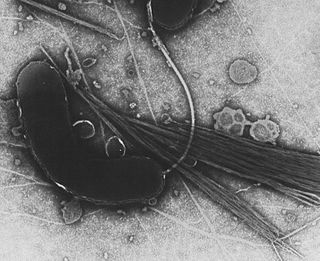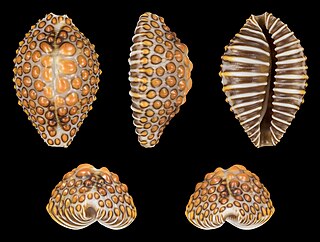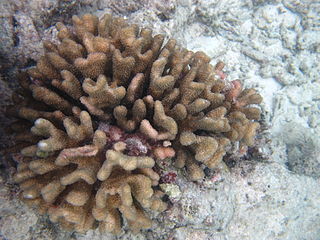
The Vibrionaceae are a family of Pseudomonadota given their own order, Vibrionales. Inhabitants of fresh or salt water, several species are pathogenic, including the type species Vibrio cholerae, which is the agent responsible for cholera. Most bioluminescent bacteria belong to this family, and are typically found as symbionts of deep-sea animals.
Fragmentation in multicellular or colonial organisms is a form of asexual reproduction or cloning, where an organism is split into fragments upon maturation and the spilted part becomes the new individual.

The Aliwal Shoal is a rocky reef which is the remains of an ancient sand dune approximately 5 kilometres (3.1 mi) off the coast of KwaZulu-Natal, South Africa. The reef is inhabited by many kinds of hard and soft corals and other marine invertebrates, and a variety of tropical and subtropical fish species. Aliwal Shoal was named after the near-sinking in 1849 of the three-masted vessel Aliwal, captained by James Anderson. There are two wrecks near the reef that are popular recreational dive sites. The Norwegian bulk carrier MV Produce sank in 1974, and SS Nebo sank in 1884. Aliwal Shoal has diverse marine life, including large predators, and is popular as a recreational scuba diving destination. The Shoal is known especially for its abundance of Grey nurse sharks between July and November when the sharks congregate there to mate.

Puerto Ángel is a small coastal town in the Mexican state of Oaxaca located in the municipality of San Pedro Pochutla. It, along with San Agustinillo and Playa Zipolite are known as the "Riviera Oaxaqueña". It is located 9 km south of city of Pochutla approximately 50 kilometers west of Huatulco and 80 kilometers east of Puerto Escondido. Despite tourism development since the 1960s, the town is still mostly a fishing village, located on a small bay surrounded by rocky hills that lead into the Sierra Madre del Sur. It was founded in the mid-19th century as a port for the region's coffee and lumber industries but since then other means of shipping these products has replaced it.

Pocillopora meandrina, commonly known as cauliflower coral, is a species of coral occurring in the Indo-Pacific and Pacific oceans. This coral lives in shallow reef environments.

Jenneria pustulata, common name the Jenner's cowry or pustulated cowry, is a species of small sea snail, a marine gastropod mollusk in the family Ovulidae, one of the families of cowry allies.

Pocillopora is a genus of stony corals in the family Pocilloporidae occurring in the Pacific and Indian Oceans. They are commonly called cauliflower corals and brush corals.

The Pocilloporidae are a family of stony corals in the order Scleractinia occurring in the Pacific and Indian Oceans.
Pocillopora inflata is a species of stony coral in the family Pocilloporidae. It was first described by Peter William Glynn in 1999. It is found growing on coral reefs in the tropical eastern Pacific Ocean but is nowhere abundant.
Vitrella brassicaformis (CCMP3155) is a unicellular alga belonging to the eukaryotic supergroup Alveolata. V. brassicaformis and its closest known relative, Chromera velia, are the only two currently described members of the phylum Chromerida, which in turn constitutes part of the taxonomically unranked group Colpodellida. Chromerida is phylogenetically closely related to the phylum Apicomplexa, which includes Plasmodium, the agent of malaria. Notably, both V. brassicaformis and C. velia are photosynthetic, each containing a complex secondary plastid. This characteristic defined the discovery of these so-called 'chromerids,' as their photosynthetic capacity positioned them to shed light upon the evolution of Apicomplexa's non-photosynthetic parasitism. Both genera lack chlorophyll b or c; these absences link the two taxonomically, as algae bearing only chlorophyll a are rare amid the biodiversity of life. Despite their similarities, V. brassicaformis differs significantly from C. velia in morphology, lifecycle, and accessory photosynthetic pigmentation. V. brassicaformis has a green color, with a complex lifecycle involving multiple pathways and a range of sizes and morphologies, while Chromera has a brown color and cycles through a simpler process from generation to generation. The color differences are due to differences in accessory pigments.

Yale-NUS College is a liberal arts college in Singapore. Established in 2011 as a collaboration between Yale University and the National University of Singapore, it is the first liberal arts college in Singapore and one of the first few in Asia. With an average acceptance rate of 5.2%, it is among the most selective institutions in the world. Yale-NUS was the first institution outside New Haven, Connecticut that Yale University had developed in its 300-year history, making Yale one of the first American Ivy League schools to establish a college bearing its name in Asia.

Eucidaris thouarsii, the slate pencil urchin, is a species of cidaroid sea urchins that inhabits littoral regions of the East Pacific Ocean.

Pocillopora damicornis, commonly known as the cauliflower coral or lace coral, is a species of stony coral in the family Pocilloporidae. It is native to tropical and subtropical parts of the Indian and Pacific Oceans.

Pocillopora verrucosa, commonly known as cauliflower coral, rasp coral, or knob-horned coral, is a species of stony coral in the family Pocilloporidae. It is native to tropical and subtropical parts of the Indian and Pacific Oceans.

Pocillopora grandis, is a colonial species of stony coral in the family Pocilloporidae. It is known commonly as antler coral, and is found in the Indo-West Pacific to the Eastern Tropical Pacific.

Pocillopora elegans is a species of colonial stony coral in the family Pocilloporidae. It is native to tropical and subtropical parts of the western, central and eastern Pacific Ocean. It is susceptible to bleaching and various coral diseases and the International Union for Conservation of Nature (IUCN) has listed it as a "vulnerable species".
Pocillopora fungiformis is a species of colonial stony coral in the family Pocilloporidae. It is native to Madagascar. It is a mostly encrusting species and grows in patches up to 2 m (7 ft) across.

Pocillopora capitata, commonly known as the cauliflower coral, is a principal hermatypic coral found in the Eastern Tropical Pacific. P. capitata is a colonial species of stony coral of the class Anthozoa, the order Scleractinia, and the family Pocilloporidae. This species was first documented and described by Addison Emery Verrill in 1864. P. capitata is threatened by many of the effects of climate change, including — but not limited to — increased temperatures that cause bleaching and hypoxic conditions.
Caracanthus typicus, the Hawaiian orbicular velvetfish, is a species of marine ray-finned fish, an orbicular velvetfish, belonging to the family Scorpaenidae. This species is endemic to the Hawaiian Islands.












